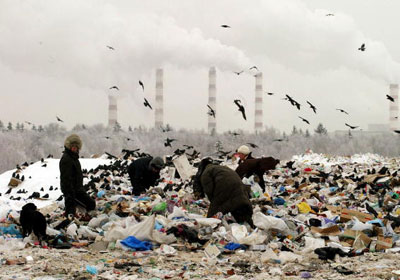Unless you’re in the oil business, there’s little reason to brave the choking pollution of Baku, Azerbaijan. Fetid water, oil ponds and life-threatening levels of air pollution emitted from drilling and shipping land the former Soviet manufacturing center at the bottom of this year’s list as the world’s dirtiest city.
Baku is bad, but far from alone. For residents of the 25 cities on this year’s list, black plumes of smoke, acid rain and free-flowing sewage are part of everyday life. Not as immediately visible: the impact on the population’s health and life expectancy.
To see which cities in the world were dirtiest, we turned to Mercer Human Resource Consulting’s 2007 Health and Sanitation Rankings. As part of their 2007 Quality of Life Report, they ranked 215 cities worldwide based on levels of air pollution, waste management, water potability, hospital services, medical supplies and the presence of infectious disease.
In Pictures: The World’s 25 Dirtiest Cities

POLLUTION TO THE OROYA CITY PERÚ
The years 2006 and 2007 the Blacksmith Institute have accomplished a research about the cities more contaminated to the world and arrived to the conclusion that the Oroya city was between the 10 cities more polluted of the world and, the environment Graffiti 2008 said that is between five more pollute too to the world and the 2008 Blacksmith Institute and Green Cross Switzerland say that Oroya is between the most polluted of the world. This qualifications are benevolents; according to my researchs to many years who I am publishing, the Oroya city is the more polluted to Peru, Latin America and of the world and every day is being more polluted: lead in blood in children in the Ancient Oroya in average 53.7 ug/dl ( DIGESA 1999); pregnancies women 39.49 ig/dl ( UNES 2000), new borns children 19.06 ug/dl, puerperal 319 ug/100 grams/placenta ( Castro 2003) and workers 50 ug/dl ( Doe Run 2003).Top lead in blood accepted 10 ug/dl; present day is 0 ug/dl ( Pediatric of Academy to USA)
When the Oroya city was in hands to the CentroMin eliminated only by the upper chimney to 167.500 meters, in average by day in tons: sulfur dioxide 1000, lead 2500, arsenic 2500, cadmium 40, particulate matter 50 and so on, more 24,000 to toxis gas product to the incomplete combustion of the coal, without count it is eliminated by industrial incinerator y by the 97 smalls chimneys, it is estimated 15,000; overall 45,000 tons for day (PAMA . El Complejo Metalúrgico de la Oroya, 1996); other research say that by this chimney only eliminate overall 119¨917,440 tons too every day to a velocity to 8.7 meters by second ( Chuquimantari C. Yauli-La Oroya MinerÃa y Ciudades Empresas Pág. 57, 1992)
Doe Run envoy every three months the concentrations of the heavy metals to the Ministry to the Energy and Mines and with the sames datums Ceverstav have demostrated the pollution was increased; for example the sulfur dioxide it have increased in near to 300 %, by increment to the production (Cederstav. La Oroya no Espera 2002
The American Association to the Environment say that the environmental quality to the Oroya it is serious deteriorated since that Doe Run was owner and the same enterprise
declared that the concentrations of the heavy metals gas is ncreased in the air: lead 1160 %, cadmium 1990 % and arsenic 6006 % (Portugal, et al. Los Humos de Doe Run 2003)
Godofredo Arauzo
godo_ara@hotmail.com